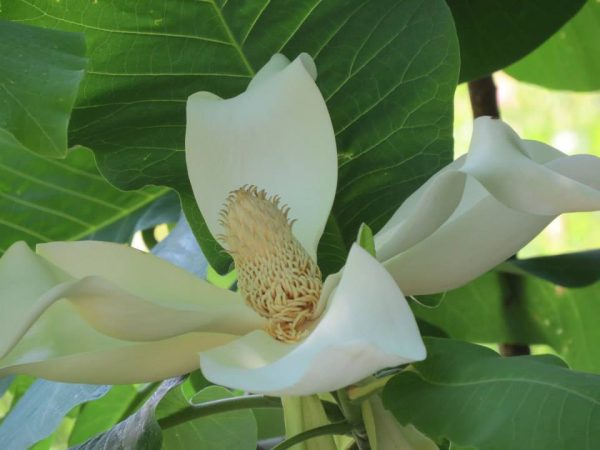A win for Redlair’s rare bigleaf magnolia

Walk through the forest at Redlair Preserve, an approximately 750-acre property preserved in Gaston County, and you will see in the understory something that look like a design by Dr. Seuss: A medium-sized tree sporting massive flowers and tropical-looking leaves that can grow 30 inches long and a foot wide. The trees are bigleaf magnolia (Magnolia macrophylla), and they are truly a remarkable sight. Now a key stronghold of this regionally imperiled tree has been named an N.C. Plant Conservation Program preserve. As such, the property will be managed to protect rare plant species.
Redlair, formerly the property of Haywood Rankin and his family, is now owned by the N.C. Plant Conservation Program, with the Catawba Lands Conservancy holding easements on portions of the property. The land preserves the bigleaf, first described by French explorer-botanist Andre Michaux in the late 1700s. The property is home to many other unique native plants, including a large population of pink lady slippers and the federally endangered Schweinitz’s sunflower.
The property itself lies along the South Fork of the Catawba River, a stretch of the river free of the reservoirs dotting the main stem of the Catawba. Though it contains a few small dams built to support late 19th- and early-20th-century power generation, the South Fork remains intact as far south as Redlair and McAdenville, before it merges with Lake Wylie.
The Redlair area includes 4.5 miles along the east bank of the South Fork and a mile along the west bank. It consists of slopes blanketed by mountain laurel (Kalmia latifolia) and floodplains with distinct riparian ecology or with low-lying alluvial land that has been farmed for centuries – including by Native Americans, as has been verified by archeological work overseen by Gastonia’s Schiele Museum of Natural History.
The South Fork cuts sharply between the west side of Spencer Mountain and the Catawba turning point (the divide along the Hickory Grove Road). The river’s abrupt turn has created intensely chiseled valleys with mountainous qualities and served as a kind of protective embrace for Redlair: The water’s steep descent means less of the land has been plowed than is typical for the Piedmont. Many of the property’s trees are more than a century old, and the land is, as Redlair’s website states, “unusually free of invasive plants.”
After more than 50 years of working with the N.C. Plant Conservation Program, and with assistance from Friends of Plant Conservation, the Rankin family at the end of last year was able to formally recognize Redlair as a plant conservation preserve and with the proceeds of the land’s sale, create a foundation to support its maintenance. And now the bigleaf magnolia has an added layer of protection, ensuring its massive leaves and flowers will surprise and impress hikers for generations to come.
Sharkira Ibrahim wrote this article while interning for the LandTrust for Centeral North Carolina in 2014. At the time she ws a student at North Carolina Agricultural and Technical State University.
Shakira Ibrahim